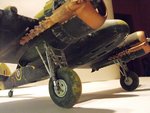I remember quite a while ago someone posted that it was a shame that completed models still have perfectly round tyres with no squashing.
So I have two questions (maybe three)
Firstly has anyone got a pic of a model showing tyre squash.
Secondly what would be the best method for achieving that effect on the parts supplied in kits ( what might be seen as the third question is it possible to buy tyre mouldings with squash moulded in)
So I have two questions (maybe three)
Firstly has anyone got a pic of a model showing tyre squash.
Secondly what would be the best method for achieving that effect on the parts supplied in kits ( what might be seen as the third question is it possible to buy tyre mouldings with squash moulded in)

